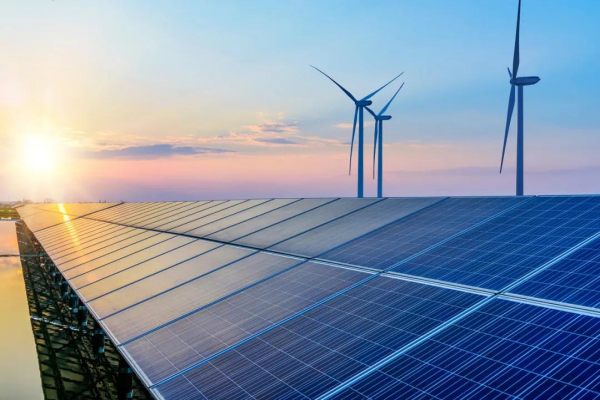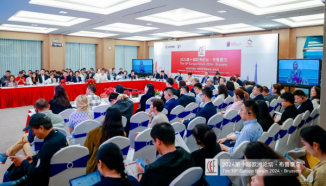The CCCEU Weekly Update 03 February 2023: On the way to materialization? Global Gateway and BRI could synergize for third-party cooperation

On the way to materialization?
Global Gateway and BRI could synergy for third-party cooperation
Editor's Note: Greetings! This edition of the CCCEU Weekly Update will give you a glimpse of the EU's Global Gateway and its nascent development; businesses call for third-party cooperation between the programme and the China-proposed Belt and Road Initiative; a milestone for the EU: wind and solar produced more electricity than gas in 2022; and more. Enjoy reading and have a restful weekend.
The "Just and Green Recovery Team Europe Initiative", which the EU provides green transition support to South Africa, was officially launched on January 27. As a part of the Global Gateway strategy, the EU and its member states will invest more than 280 million euros in South Africa under the initiative, of which 97.75 million euros come from the EU budget. 40 million euros will promote investment in public infrastructure in South Africa through blended finance. The EU and its member states will be committed to supporting South Africa's greening of municipal services, repurposing of coal power plants, energy efficiency improvement of public buildings, and start-ups of circular economy. In addition, the EU, Germany and France will also provide more than US $300 million of green financing to South Africa under the Just Energy Transition Partnership (JETP) reached at the COP 26 and 27.
The Global Gateway strategy, announced by the President of the European Commission von der Leyen in December 2021, is an important part of "A Stronger Europe in the World", one of the six priorities during 2019-2024, and promises that the EU and its member states will invest 300 billion euros in the world.
The funding sources of the strategy include not only the fiscal budget of the EU, but also financial institutions such as the European Investment Bank, the European Bank for Reconstruction and Development, the European Fund for Sustainable Development+ (EFSD+), scientific research funding programs such as Horizon Europe and private sector funds. At the same time, the EU will further improve the financial tool kit and explore the establishment of European export credit instruments.
The strategy has been questioned for the lack of practice and little substantive progress since its launch. According to the South China Morning Post, Vincent Grimaud, an official of the International Partnership Department of the European Commission, said at a hearing held by the European Parliament last November that there was no additional money when it comes to the EU level for the Global Gateway strategy.
Although the EU has reached an investment intention of 150 billion euros and 10 billion euros with African Union(AU) and Association of Southeast Asian Nations(ASEAN) respectively last year, the specific projects, sources of funds and progress have not yet been disclosed.
Moreover, the actual completion time of some case projects used to publicize the Global Gateway strategy was even earlier than the proposed time of the strategy. Some critics believe that the so-called Global Gateway may only be "old wine in new bottles", which still relies on the existing cooperation framework between the EU and its partners.
In the past month, the EU's action under the Global Gateway strategy has accelerated significantly. In addition to its support for the green transformation of South Africa, the EU launched the initiative to accelerate the training of teachers in Sub-Saharan Africa, greenlighted a number of guarantee programmes for the Balkans and the Asian-African and Latin American regions, and strengthened its partnership with the World Health Organization through investment.
According to POLITICO on January 23, the EU will launch the first 70 projects under the framework of the Global Gateway this year, including the laying of digital cables under the Black Sea, the construction of submarine optical cables connecting the Mediterranean and North African countries, and the construction of dams and hydropower stations in Cameroon. At present, the list of priority projects has been submitted to EU diplomatic officials for discussion, and further information is expected next week.
However, for the EU, the Global Gateway strategy seems like a hot potato. On the one hand, the strategy is expected to drive the development of the EU in the field of digital economy and green economy, attract the re-flow of manufacturing industry and further promote the EU standards by expanding the market; But on the other hand, the current recovery of the EU is weak, facing multiple problems such as high inflation, tight monetary policy and rising fiscal deficit. The financing of the strategy is difficult to meet expectations.
At the beginning of the Global Gateway strategy, some media interpreted it as a counterbalance or even replacement of the EU to China's Belt and Road Initiative. In response, the spokesman of the Chinese Foreign Ministry said that China welcomes all initiatives to help developing countries build and develop; Different initiatives should not be mutually substitutive and mutually exclusive, but should be inclusive and form a joint force.
In December last year, during the visit of European Council President Michel to China, Chinese President Xi Jinping also mentioned that the EU was welcomed to participate in the joint construction of the Belt and Road Initiative and other global development initiatives, and cooperate with the Global Gateway strategy of the EU. It can be seen that China and the EU have a deep consensus on bridging the global development gap. The space for win-win cooperation is very broad and is also expected to jointly bring more welfare to developing countries.
Looking forward to the future, strengthening third-party market cooperation may be an effective way for both China and the EU to achieve win-win results, that is, to effectively meet the needs of the countries where the investment is located, combine China's superior production capacity with the advanced technology of developed economies. Through tripartite cooperation, integrate the advantageous resources of all parties, eliminate doubts among countries, and promote the formation of a healthy competitive and cooperative relationship.
IMF projects China's economic growth to reach 5.2 pct in 2023
According to Xinhua, The International Monetary Fund (IMF) on Monday projected China's economy will grow by 5.2 percent in 2023, 0.8 percentage point higher than October 2022 forecast.
"Growth in China is projected to rise to 5.2 percent in 2023, reflecting rapidly improving mobility," the IMF said in the newly released update to its World Economic Outlook report.
ECB raises rates by 50 bps
According to Xinhua, As expected, the European Central Bank (ECB) on Thursday increased interest rates by 50 basis points (bps) and sent out a dovish message about the outlook for future rate hikes.
"In view of the underlying inflation pressures, the Governing Council intends to raise interest rates by another 50 basis points at its next monetary policy meeting in March and it will then evaluate the subsequent path of its monetary policy," the bank said in a statement.
Major milestone for EU energy: Wind and solar produced more electricity than gas in 2022
According to euronews, Wind and solar power produced more of the EU's electricity than fossil gas for the first time last year.
The renewable energies were responsible for a record fifth (22 per cent) of the bloc's electricity, a new report from clean energy think tank Ember shows.
Exports of intermediate goods post sustained growth in second quarter of 2022
World exports of intermediate goods (IGs) grew 4% year-on-year in the second quarter of 2022 to US$ 2.5 trillion, driven by the increase in shipments of intermediate food products. The overall growth, while slower than the increase recorded in the same period a year ago, continues to indicate stable activity in global supply chains.
EU unveils green industry deal to compete with U.S.
According to Xinhua, The European Commission on Wednesday unveiled its plan to meet the challenges posed by the United States'(U.S.) Inflation Reduction Act (IRA) and keep up with a worldwide race in subsidy schemes for green industries.
Net-zero industries are most important in the fight against climate change, European Commission President Ursula von der Leyen said when presenting the Green Deal Industrial Plan.
Ministry of Commerce: Take advantage of China's ultra-large-scale market to stabilize the global trade supply chain
Li Xingqian, director of the Foreign Trade Department of the Ministry of Commerce, answered reporters' questions and said that in general, China's foreign trade in 2022 will have three major A wonderful performance is to stand on a new height, release new kinetic energy, and make new contributions.
Regarding new kinetic energy, last year, represented by the "new three" of electricity, light, and lithium, that is, the export of electric vehicles, photovoltaic products, and lithium batteries. Our country's high-tech, high value-added products that lead green transformation become a new growth point of export.
What are experts talking about?
"Global Economic Uncertainty Continues to Increase" by Dongyan, Researcher of Institute of World Economics and Political Science, Chinese Academy of Social Sciences. The article pointed out that the global economy will continue the slowdown trend of 2022 in 2023, showing a mild recession; the global inflation rate is expected to decline, but will still be higher than the level before the international financial crisis; the outlook for world trade is also hardly optimistic due to the decline in global economic growth and geopolitical conflicts. Overall, the global economy is still facing considerable challenges this year, but the adjustment process is at the same time breeding recovery momentum, and countries need to strengthen economic coordination through multilateral cooperation to promote global economic recovery.
"Economic and Budgetary Outlook for the European Union 2023" offering an overview of the economic and budgetary situation in the European Union and beyond, and summarising the main economic indicators in the EU and euro area and their two-year trends, this study is the seventh in an annual series of 'Outlooks' produced by the European Parliamentary Research Service (EPRS). The authors of the publication explain and analyse the annual EU budget and give an overview of its headings for 2023, all within the wider budgetary context of the EU's post-2020 multiannual financial framework and the Next Generation EU recovery instrument.
Please note: the English version of this issue is slightly different from our Chinese one. The views and opinions expressed in this article do not necessarily reflect the official position of the CCCEU.

 Login
Login Login
Login CCCEU and Gunnercooke Successfully Host Webinar on CSDDD and FLR Compliance to Guide Chinese Businesses
CCCEU and Gunnercooke Successfully Host Webinar on CSDDD and FLR Compliance to Guide Chinese Businesses Cultivating responsible China-EU business leaders essential to tackling global challenges
Cultivating responsible China-EU business leaders essential to tackling global challenges



